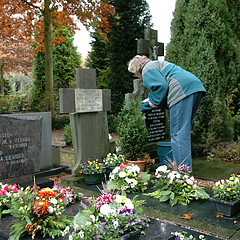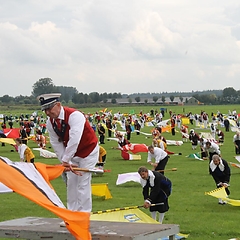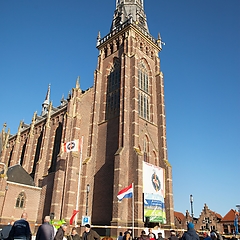The Easter customs in Denekamp consist of a number of elements and take place under the leadership of Judas and Iscariot. These are two young men who have the honour to be at the forefront of the tradition. This task rotates, the Iscariot being the newcomer of the couple and the Judas the Iscariot of the previous year. It starts with the eier gadder'n (egg gathering) on Palm Sunday. For this the Denekamp youth gathers at the St. Nicholas church. Led by Judas & Iscariot, a tour through the village starts at 1 o’clock p.m. precisely. Singing, they ring the doorbells with the request: Eier, eier, geld is ôk goat (dialect for: Eggs, eggs, money is okay too! Eggs and money are collected to cover the costs of the Easter customs.
On Easter Saturday the male part of the population gathers at the St. Nicolas church to fetch the Easter wood. Led by Judas & Iscariot they go to the forest to fetch wood. With this wood the Easter fire is built on the Easter meadow. On Easter Sunday 'de Kul neighbourhood' and 'the residents of Brink' gather at the St. Nicolas church. Symbolically this stands for the whole population of Denekamp.
At the church Judas & Iscariot have made themselves ready to start off to the Singraven estate at the stroke of 1 p.m. At the castle they ask for an Easter stake. The lord of the castle offers the people in the woods a choice of three trees. The chosen tree is cut down and pulled by 'human chains' via the church to the Easter meadow. On the Easter meadow a wooden barrel (with steel rings) is attached to the Easter stake with a chain. After this, with the help of six wooden ladders and joint forces, it is placed upright next to the Easter fire. When the Easter stake is upright, it is fixed with the ladders. Alternately Judas & Iscariot then climb the highest ladder to address the crowd. They introduce themselves, to which the crowd reacts critically. Judas then sells the Easter stake and the rings (which remain after the burning of the barrel) to the highest bidder in the crowd. Finally, he invites all the listeners to be present in the evening when the barrel and the Easter fire are lit.
In the evening, at 8 p.m., the Easter stake is climbed again by Judas & Iscariot; they then light the barrel and the Easter fire. During the burning of the barrel and the Easter fire, people circle around the fire singing the Denenkamp Easter songs. When the barrel is burnt out, the stake is manually laid down flat. When afterwards the Easter fire is extinguished, the Easter tradition comes to an end for the year in question.



